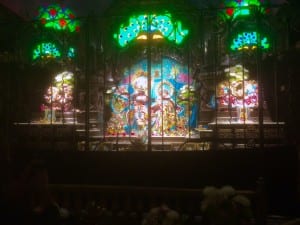Upon first site of the Kalachandji Temple, I noticed to the sort of “Lego-like” additions to the former church that stood there. While it looked like a theme park version of a Hare Krishna temple, inside, it was an open and inviting place. We began with a quick tour given by a man in traditional Indian garb (so I assume in my ignorance), a shaved head with a small ponytail, and a small streak of paint coming down from his forehead to the tip of his nose. His demeanor is one of genuine happiness and excitement for us being there. He begins the tour with a quick walk through of the restaurant and then we move down the polished hallway to the worship area.
Once in the worship area, we were treated to a brief history of the Hare Krishna movement and some of the teachings. It is at this point where I begin to question the authenticity of this history coming from a white man who is an obvious convert. He tells these stories as if they were passed down to him from his grandparents, but they were not. As I type this, I am running through the things I could say about cultural appropriation and how his very action belittles the message that he is trying to get across. It is here where I recall the Hopkins article talking about how the movement is a constant search for one’s identity and is very open ended. Bhaktivedanta did not begin spreading his message until well into the 20th century. This is by and large, a Cold War era religious movement. It is a product of globalization. It is founded on the principle that people will take away from it what they want to take away from it. This is not the music festivalgoer wearing a headdress and living in a teepee for a week, these are people who feel a genuine connection to this very modern religious movement.
One of the most striking things once I stepped into the worship area was the statue of Bhaktivedanta that is seated facing the entrance of the room. It felt like a real human presence and for our tour guide, he was. He spoke of him in the same way that Project Mayhem talks about Tyler Durden in Fight Club. He set up temples throughout the world and inspired a remarkable global movement. The art that this movement has inspired is sprawled across the walls. They look like they could have been made a 1000 years ago, but they too are from the 20th century. They all depict stories and tales about Krishna. They are monuments to both the power he possess and his humanness. In a fenced in area is a shrine to various gods, who are represented by figurines and statues. At certain times in the day, designated leaders will give these gods offerings of food. These are not the offerings of blood and cooked bits of meat that we come to think of when talking about offerings. These are offerings of traditional vegetarian dishes. Our tour guide will go on to tell us about how each god will be dressed and undressed in individual pieces of cloth. They each have their own personality and role in the religion.

As the tour is drawing to a close, more and more people are filing in to the room for the evening prayer and song. Worshippers will bow as they walk in and will make their way to Bhaktivedanta statue and lay flat on their stomach with their arms stretched above their heads and pray. The tour ends as the worshippers begin singing to the shrine of gods. Singing are people that look like they’re from various backgrounds. There are the professionals, students, and volunteers. While this religion has its foundations set in India, it resonates with people from all walks of life.

